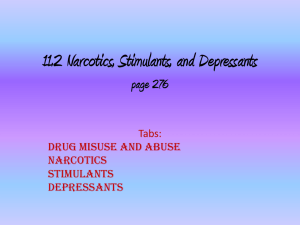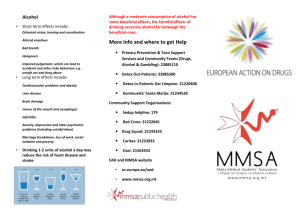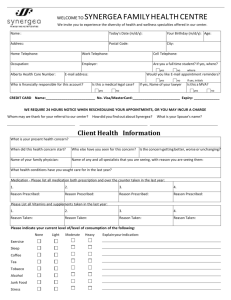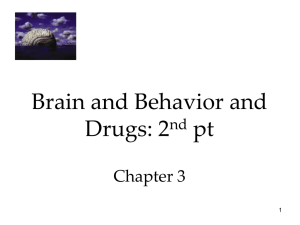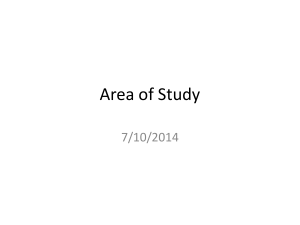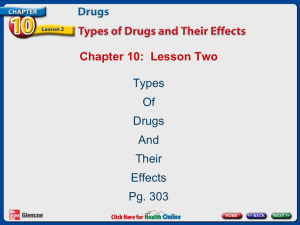drug awareness, young people & parental subatance use
advertisement
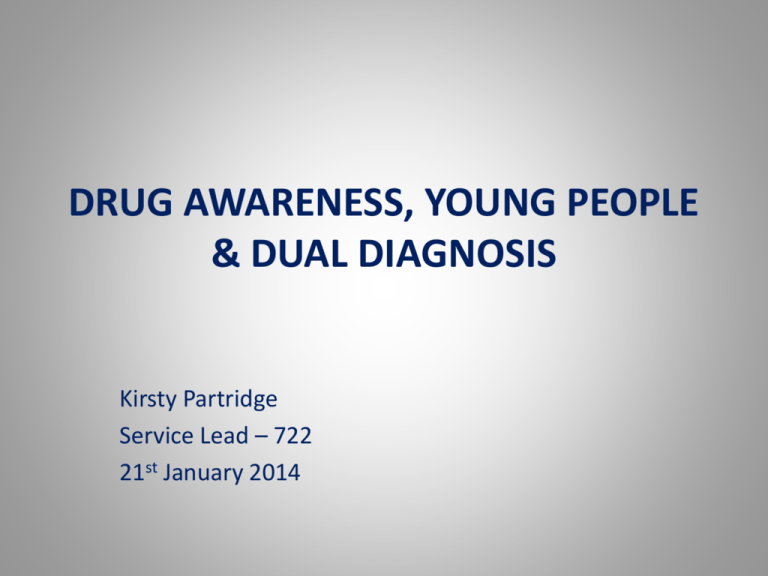
DRUG AWARENESS, YOUNG PEOPLE & DUAL DIAGNOSIS Kirsty Partridge Service Lead – 722 21st January 2014 • What do you understand about drugs and drug use? Different drug categories • Stimulants • Depressants • Hallucinogens • Prescribed drugs Stimulants • Cocaine, Crack Cocaine, Amphetamines (speed), Methamphetamine (crystal meth, ice) Tobacco,Ecstasy (MDMA), Dexamphetamine (Dexy’s), Amyl Nitrate (Poppers), Khat/ Quat Stimulants are drugs that stimulate the brain and central nervous system, speeding up communication between the two. Your everyday coffee is a stimulant, those who stop drinking coffee may suffer withdrawal symptoms. Depressants • Cannabis ,GHB ,Inhalants/ Solvents,Opiates (Heroin, Morphine, Codeine, Methadone, Opium, Pethidine), Alcohol, Benzodiazepines (Diazepam/ Valium, Lorazepam) Depressants slow down the activity of the brain and central nervous system, slowing down the communication between the two. For medical purposes they can calm nerves, relax muscles and some prescribed depressants are useful for disorders such as insomnia or anxiety. If two or more depressants are used together, you are at greater risk of respiratory failure (eg: alcohol & Benzodiazepines) Hallucinogens • LSD, Magic Mushrooms (Psilocybin), PCP (Phencyclidine), Ketamine, Mescaline Hallucinogens interfere with the brain and central nervous system in a way that results in radical distortions of a user’s perception of reality. Profound images, sounds and sensations can be experienced, but they will not actually exist. Prescribed Drugs • Painkillers: Some prescribed painkillers such as Codeine, Co-Codamol & Dihydrocodeine are Opiate based & if used over a long period of time may lead to physical dependence. • Benzo’s: Many people are prescribed Benzodiazepines (Benzo’s) for anxiety, panic attacks, insomnia, muscle spasms & agitation Legal Highs/NPSs (New Psychoactive Substances) • 'Legal Highs’ are substances which produce the same or similar effects, to drugs such as cocaine and ecstasy, but are not controlled under the Misuse of Drugs Act. They are however, considered illegal under current medicines legislation to sell, supply or advertise for “human consumption”. To get round this sellers refer to them as research chemicals, plant food, bath crystals or pond cleaner. • In many cases, ‘legal highs’ have been designed to mimic class A drugs, but are structurally different enough to avoid being classified as illegal substances under the Misuse of Drugs Act. The Government has now introduced new powers, meaning they can place a temporary ban on any potentially harmful substance, while they await a recommendation from the Advisory Council on the Misuse of Drugs (ACMD), an independent group of experts, on whether it should be permanently controlled under the Misuse of Drugs Act 1971. When it is used, the temporary ban will come into immediate effect, but it will have to be agreed by Parliament within 40 days. The drug will not be Class A, B, or C, but called a temporary class drug. It would not be illegal to posses a temporary class drug for personal use, but the police could confiscate it and destroy it. It will be illegal to import, distribute and sell the drug , and anyone caught could be fined, sent to jail or both. There are now 251 known NPSs compared with 234 controlled drugs. But the report warns that new varieties are entering the market at a rate of one per week, sold through a network of legal websites, through which even school-age children can buy drugs. ‘UN/EU report Aug 2013’ Why do young people use substances? • • • • • • • • • Experimentation Boredom Peer pressure Fun The high Socially acceptable To block out pain Addiction Self medicating If you feel good/better, what's the problem? • Positive effects may be short lived • Believe can control use, but not always • Pleasure reduces and use may be to feel ‘normal’ • May need higher dose/more often • Self-control impaired • Compulsive seeking & use despite harmful consequences: physical & mental health, social, personal, financial, legal What are the groups we consider to be vulnerable? • In the criminal justice system or at risk of offending • Looked after or at risk of becoming looked after • Excluded from school, persistent truants or at risk of exclusion • NEET • Drug or alcohol using parents/carer/sibling • Homeless young people • Young people abused through sexual exploitation • Teenage mothers • MH service users What protective factors are there? • Supportive family environment • Good social support system • Caring relationship with at least one adult • Attending school • In employment • Intellectual/emotional ability • Positive temperament • Outside interests WHAT IS DUAL DIAGNOSIS? “The concurrent existence in an individual of substance misuse and one or more mental disorders” (Franey & Quirk, 1996) Brain Chemistry • Most illegal drugs cause the release of a neurotransmitter called dopamine • The release of dopamine is why drugs feel pleasurable • However too much dopamine could cause problems • Most drugs used to treat schizophrenia work by reducing dopamine • Stimulant drugs can also effect the ability to produce serotonin, which can lead to long lasting difficult to treat depression Cannabis & the Brain - Most drugs usually fall into category of stimulant, depressant, hallucinogen or prescribed drugs. Cannabis exhibits a mix but leans toward hallucinogen due to THC (Tetrahydrocannabinol) - THC binds to and activates specific receptors in parts of the brain that control memory, thought, concentration, time and depth perception and coordinated movement. - By activating these receptors, THC interferes with the normal functioning of the cerebellum WHAT CAME FIRST? ‘VULNERABILITY GROUP’ • Use pre-dates illness by 1-5 years. • Impact of use reduces vulnerability threshold/coping resources. ‘STRESS GROUP’ • Concurrent onset of illness/substance use. • Already susceptible and substance use acts as a stress factor precipitating onset. ‘COPING GROUP’ Substance use post-dates illness. Self-medication of symptoms/side effects. Source: Hambrecht and Hafner (2003) PRACTICAL DEFINITION OF DUAL DIAGNOSIS Further reading • Advisory Council on the Misuse of Drugs. (2003) Hidden Harm: responding to the needs of problem drug users, London: Home Office • Kearney, P, Levin, E & Rosen, G. (2003) Alcohol, Drug & Mental Health Problems: working with families, London: SCIE • http://www.nta.nhs.uk/uploads/yp2012vfinal.pdf •‘Supporting information for the development of joint local protocols between drug and alcohol partnerships, children and family services’ (NTA 2011) •www.nta.nhs.uk •www.dh.gov.uk •www.drugs.homeoffice.gov.uk •www.scie.org.uk •www.everychildmatters.gov.uk •www.talktofrank.com • Contact details: • Kirsty Partridge Service Lead – 722 Waltham Forest 0300 555 1158 kirsty.partridge@nelft.nhs.uk
